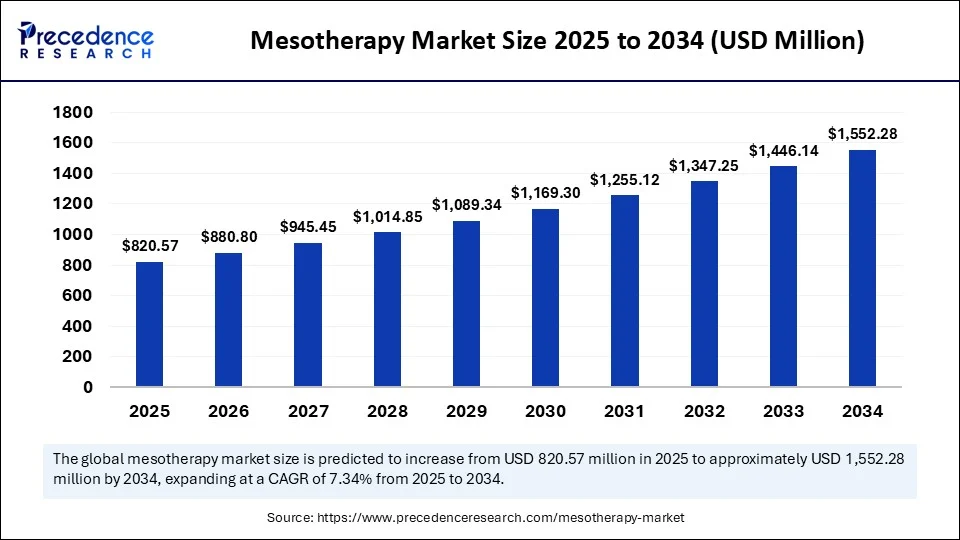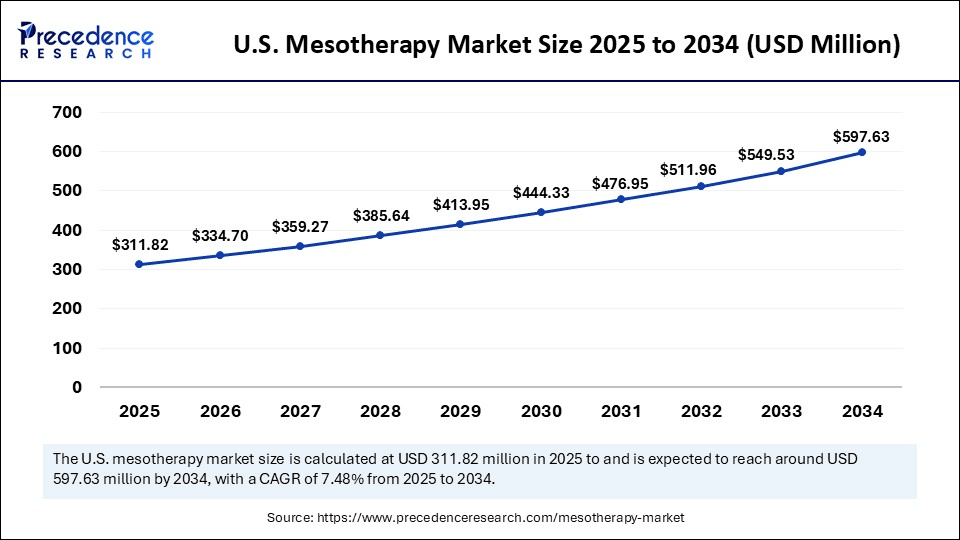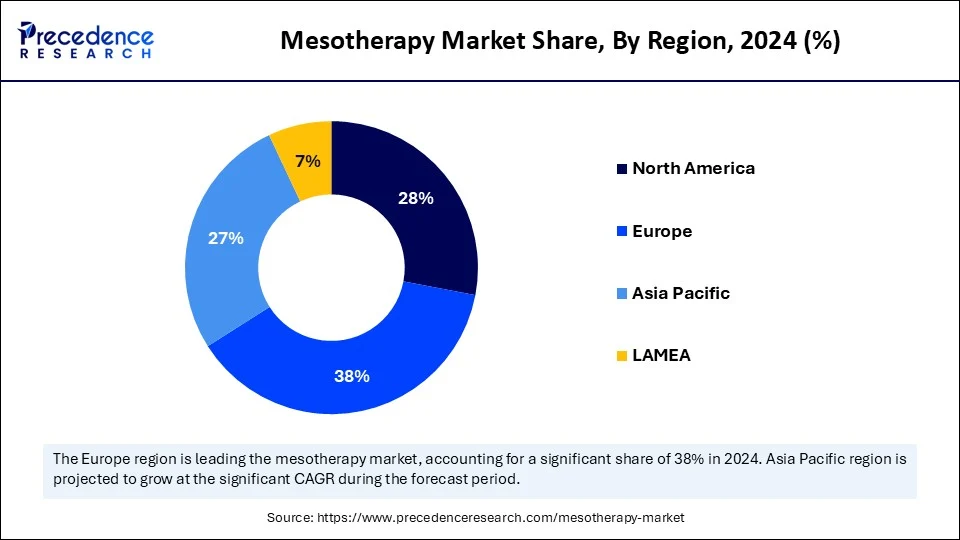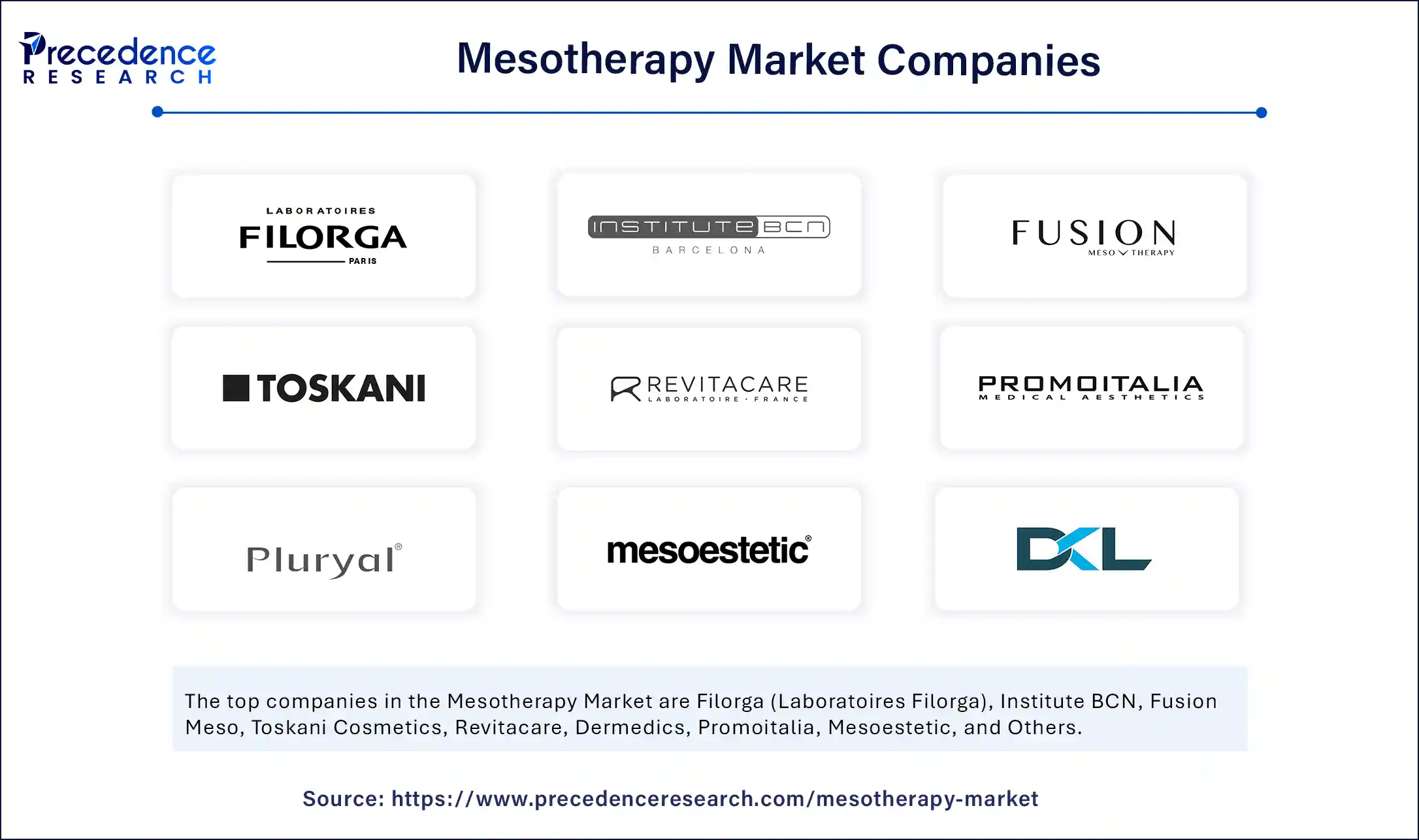List of Contents
Mesotherapy Market Size and Forecast 2025 to 2034
The global mesotherapy market size accounted for USD 764.46 million in 2024 and is predicted to increase from USD 820.57 million in 2025 to approximately USD 1,552.28 million by 2034, expanding at a CAGR of 7.34% from 2025 to 2034. The growth of the mesotherapy market is attributed to the rising demand for minimally invasive procedures and increased awareness of aesthetic treatments.

Mesotherapy Market Key Takeaways
- In terms of revenue, the global mesotherapy market was valued at USD 764.46 million in 2024.
- It is projected to reach USD 1,552.28 million by 2034.
- The market is expected to grow at a CAGR of 7.34% from 2025 to 2034
- Europe dominated the mesotherapy market with the largest market share of 38% in 2024.
- Asia Pacific is expected to expand at the fastest CAGR between 2025 and 2034.
- By product type, the mesotherapy solutions segment held the biggest market share in 2024.
- By product type, the mesotherapy devices segment is expected to grow at a significant CAGR between 2025 and 2034.
- By ingredient type, the hyaluronic acid segment captured the highest market share in 2024.
- By ingredient type, the peptides & nucleic acids segment is expected to grow at a remarkable CAGR between 2025 and 2034.
- By application type, the skin rejuvenation and anti-aging segment contributed the major market share in 2024.
- By application type, the hair loss/alopecia treatment is expected to grow at a remarkable CAGR between 2025 and 2034.
- By end-user type, the dermatology clinics segment led the market in 2024.
- By end-user type, the medspas segment is expected to grow at a remarkable CAGR between 2025 and 2034.
- By distribution channel, the distributors / wholesalers segment generated the major market share in 2024.
- By distribution channel, the online channels segment is expected to grow at a significant CAGR between 2025 and 2034.
How is AI Impacting the Mesotherapy Market?
Artificial Intelligence (AI) is revolutionizing the mesotherapy market by enhancing treatment accuracy and personalization. AI-powered imaging systems are helping dermatologists map the skin at a micro level, ensuring precise delivery of meso-solutions. Algorithms can now predict skin behavior, optimize ingredient combinations, and monitor post-treatment recovery in real time. Virtual consultation tools powered by AI are improving access to professional advice, especially in remote areas. Moreover, machine learning algorithms are being integrated into mesotherapy devices for real-time adjustment of injection parameters. This technological convergence is boosting consumer trust and improving treatment outcomes, accelerating global market growth.
Europe Mesotherapy Market Size and Growth 2025 to 2034
The Europe mesotherapy market size is exhibited at USD 311.82 million in 2025 and is projected to be worth around USD 597.63 million by 2034, growing at a CAGR of 7.48% from 2025 to 2034.

What Made Europe the Dominant Region in the Mesotherapy Market?
Europe dominated the market in 2024. The region benefits from strong regulatory support, advanced aesthetic infrastructure, and high consumer awareness. European clinics are at the forefront of innovation, offering customized mesotherapy solutions that attract both local and international clients. Moreover, the presence of leading cosmetic product manufacturers enhances accessibility and trust in meso-solutions. Public preference for natural, non-invasive enhancements further boosts market penetration. Medical tourism, particularly in Eastern Europe, also contributes to Europe's leadership in this sector.
France is a major player in the market, where mesotherapy originated. It continues to be a trusted mainstream treatment. Germany has witnessed increasing demand, especially in metropolitan areas with aging populations. Spain and Italy are witnessing a rise in interest from younger clients, who are focused on skin brightening and anti-aging. The UK market is growing steadily due to the rise of private clinic chains. Throughout the EU, supportive regulatory policies continue to strengthen the region's market position.

Asia-Pacific: The Fastest-Growing Region
Asia-Pacific is emerging as the fastest-growing region in the mesotherapy market. The market growth in the region is driven by the increasing prevalence of skin diseases and hair loss. There is a high demand for skin-whitening, anti-aging, and hair regrowth treatments in countries like South Korea, Japan, and India. The influence of K-beauty and J-beauty trends is shaping consumer expectations, pushing clinics to adopt advanced mesotherapy offerings. There's a cultural openness to skin enhancement procedures, especially in beauty-conscious cities. Growing medical tourism in Thailand, Singapore, and Malaysia further propels regional demand. In addition, social media exposure and local celebrity endorsements are accelerating the acceptance of cosmetic injectables.
India is experiencing remarkable growth, particularly in Tier 1 and Tier 2 cities. A younger population, increasing acceptance of aesthetic medicine, and rising stress-related hair loss issues are driving demand. Clinics and dermatology chains are offering affordable mesotherapy packages targeting middle-income groups. Educational campaigns and influencer marketing are helping to reduce the stigma surrounding aesthetic treatments. The entry of international brands and tech-driven clinics is further raising treatment standards.
Market Overview
The mesotherapy market comprises products, services, and technologies used for delivering active ingredients such as vitamins, enzymes, hormones, and plant extracts into the skin's mesodermal layer to treat a variety of medical and cosmetic conditions. Mesotherapy is widely used in dermatology, aesthetics, and pain management to address issues like skin rejuvenation, hair loss, body contouring, cellulite reduction, and localized fat removal. The market includes mesotherapy solutions, devices (injectors and guns), and related consumables, offered through hospitals, dermatology clinics, medspas, and aesthetic centers.
The mesotherapy market is witnessing robust growth, driven by rising demand for non-invasive cosmetic solutions. Consumers are increasingly favoring mesotherapy for its minimal downtime, affordability, and visible results. Clinics and medspas are expanding service portfolios to include mesotherapy for facial rejuvenation, fat reduction, and hair regrowth. The aging population and growing middle-class spending power in emerging economies are also fueling demand. Technological advancements in meso-gun devices and needle-free injectors are further transforming the treatment landscape. The market is diversifying rapidly, appealing to both medical and aesthetic consumers.
Key Trends in the Mesotherapy Market
- Rising popularity of combination therapies: Mesotherapy is increasingly combined with other treatments, such as PRP, microneedling, and laser therapy, to enhance results.
- Surge in male aesthetics treatment:More men are turning to mesotherapy for hair regrowth, facial rejuvenation, and body contouring. This trend is prompting clinics to create gender-specific services and products.
- Growth in at-home and needle-free devices: Technological innovation is making mesotherapy more accessible through needle-free injectors and portable devices.
- Expanding use in hair restoration: Mesotherapy is becoming a go-to treatment for androgenic alopecia and stress-related hair loss. Dermatologists are increasingly recommending it as a supportive or alternative option.
Market Scope
| Report Coverage | Details |
| Market Size by 2034 | USD 1,552.28 Million |
| Market Size in 2025 | USD 820.57 Million |
| Market Size in 2024 | USD 764.46 Million |
| Market Growth Rate from 2025 to 2034 | CAGR of 7.34% |
| Dominating Region | Europe |
| Fastest Growing Region | Asia Pacific |
| Base Year | 2024 |
| Forecast Period | 2025 to 2034 |
| Segments Covered | Product Type, Ingredient Type, Application,End User, Distribution Channel, and Region |
| Regions Covered | North America, Europe, Asia-Pacific, Latin America, and Middle East & Africa |
Market Dynamics
Drivers
Social Media Influence and Celebrity Endorsement
The booming influence of social media is a major driver of the mesotherapy market. Platforms like Instagram and TikTok have made beauty treatments more accessible and desirable. Influencers and celebrities frequently showcase before-and-after transformations, sparking curiosity among viewers. This has contributed to a surge in younger demographics seeking preventive skincare treatments. Clinics are leveraging digital marketing to promote mesotherapy as a lifestyle enhancement tool. The immediacy and visual impact of online platforms continue to normalize aesthetic procedures. This cultural shift is significantly boosting demand across all age groups.
Restraint
Lack of Standardization and Regulatory Barriers
A major challenge in the mesotherapy market is the lack of standardized protocols and global regulation. Variability in practitioner training and ingredient sourcing can affect treatment outcomes. This inconsistency can lead to skepticism among potential consumers and hesitation from healthcare authorities. Moreover, in some regions, mesotherapy is still seen as a gray-area procedure, lacking medical endorsement. The industry must work toward clearer guidelines, certification programs, and safety validation to build consumer confidence. Addressing these concerns will be essential for the market's long-term sustainability and credibility.
Opportunity
Expansion in the Male Aesthetic Segment
Traditionally female-focused, the mesotherapy market is seeing a rising influx of male clients seeking treatments for hair loss, skin rejuvenation, and fat reduction. Clinics are now tailoring services and marketing strategies to attract this growing segment. There is a significant untapped potential in urban male consumers who are becoming more open to minimally invasive cosmetic solutions. Offering discreet, fast-recovery treatments is key to converting this audience. Additionally, mesotherapy's effectiveness in targeting localized fat has become a strong draw for men. This shift presents lucrative opportunities for both product innovation and service diversification.
Product Type Insights
Why Did the Mesotherapy Solutions Segment Dominate the Market in 2024?
The mesotherapy solutions segment dominated the mesotherapy market in 2024. The dominance of the mesotherapy solutions stems from their widespread application in aesthetic treatments. These injectable formulations, which are rich in vitamins, enzymes, hormones, and plant extracts, are the primary components of most procedures. Clinics prefer ready-to-use or customizable solutions tailored to skin rejuvenation, fat reduction, and pigmentation. The convenience, cost-effectiveness, and versatility of these formulations make them a go-to choice for both professionals and patients. Leading brands offer extensive solutions, further strengthening their accessibility across dermatology clinics and medspas.
Ongoing R&D efforts have improved the efficacy and safety profiles of these solutions, making them suitable for a broader range of skin types and conditions. Multi-action blends that combine antioxidants, amino acids, and peptides are gaining popularity for delivering visible results with fewer sessions. Moreover, the ease of integration into existing aesthetic protocols continues to push the boundaries of solution-based mesotherapy. Personalized meso-cocktails formulated for individual needs are now a differentiating factor among top-tier clinics. The rise in preventive skincare and early intervention trends also supports the growth of this segment. As consumer awareness about active ingredients rises, solutions with clean-label, organic, or biocompatible claims are finding increasing favor. Additionally, the growing demand for anti-aging and targeted skincare has provided a consistent boost to this segment.
The mesotherapy devices segment is expected to experience rapid growth in the coming years, driven by increasing demand for precision, minimal downtime, and procedural efficiency. These devices include microneedle pens, automated injectors, and needle-free systems, all designed to enhance drug delivery and patient comfort. Clinics and spas are investing in these tools to reduce practitioner fatigue, standardize dosage delivery, and minimize complications. The use of electronic injectors, in particular, has revolutionized treatment for sensitive areas of the scalp and face. Device manufacturers are also focusing on compact, portable models for mobile practitioners and home-use adaptations. The growing popularity of pain-free and non-invasive beauty treatments makes these devices even more appealing.
The trend toward digitization and automation in skincare services has given rise to smart mesotherapy tools with customizable settings, memory functions, and real-time feedback. These innovations are especially popular in developed markets where tech-savvy clients seek the latest advancements. Furthermore, hybrid devices that combine mesotherapy with LED light or radiofrequency therapy are now being launched to target deeper dermal layers. Rental models and subscription services have made these high-end devices accessible to smaller aesthetic practices and new entrants. Device-based mesotherapy also enhances brand trust by offering consistency and visible results. As practitioners strive to streamline procedures while enhancing the client experience, the device segment is expected to continue outpacing traditional methods.
Ingredient Insights
What Made Hyaluronic Acid the Dominant Segment in the Mesotherapy Market in 2024?
The hyaluronic acid segment dominated the market with a major share in 2024 due to its superior hydrating, plumping, and collagen-boosting properties. This naturally occurring molecule is revered for its compatibility with the skin and immediate visible results. In mesotherapy, HA is used to treat fine lines, dehydration, and loss of elasticity, making it a crucial component in anti-aging protocols. It is also a preferred base for combining with other active ingredients, such as vitamins and peptides. The growing consumer trust in HA across dermal fillers, creams, and injectables further boosts its use in meso-formulations. Its non-allergenic, biodegradable nature ensures minimal side effects and high patient satisfaction.
Manufacturers are now offering HA in varying molecular weights to suit different skin depths and treatment goals. This allows dermatologists to tailor regimens more precisely, enhancing treatment outcomes. Cross-linked hyaluronic acid variants are emerging to provide longer-lasting effects and enhanced skin volume. As the clean beauty movement grows, HA derived from plant or biofermentation sources is gaining traction. Moreover, patient demand for minimal-downtime hydration therapies has elevated HA as the go-to meso ingredient. With increasing clinical data backing its efficacy, HA will continue to dominate the mesotherapy ingredient landscape.
The peptides & nucleic acids segment is likely to grow at the fastest rate over the forecast period due to their regenerative and cellular-level benefits. Peptides stimulate collagen production and improve skin texture, while nucleic acids aid in tissue repair and cellular renewal. These biomolecules are particularly sought after in anti-aging, pigmentation, and post-procedure recovery treatments. High-performance clinics are incorporating these advanced ingredients to position themselves as premium service providers. Scientific backing and consumer demand for long-term, cellular-level skincare results are fueling their rapid adoption. Their compatibility with other meso-actives further enhances formulation flexibility and personalization.
With rising interest in biomimetic skincare and gene-based beauty solutions, peptides and nucleic acids are now considered next-gen actives. Brands are investing in R&D to create stable, effective formulations that penetrate deeper layers of skin. These ingredients are also gaining popularity in under-eye treatments, stretch mark reduction, and sensitive skin concerns. Peptides such as Matrixyl and Argireline are frequently featured in skin-tightening mesocosmetics. Nucleic acids derived from marine or biotech sources are becoming prized for their restorative impact on mature or damaged skin. As skincare becomes more science-driven, this segment is poised to lead the evolution of mesotherapy.
Application Insights
How Does the Skin Rejuvenation & Anti-Aging Segment Dominate the Mesotherapy Market in 2024?
The skin rejuvenation & anti-aging segment dominated the market with a major share in 2024 due to the increased aesthetics consciousness and demand for minimally invasive procedures. These treatments target fine lines, pigmentation, dullness, and sagging by delivering active ingredients directly into the dermis. Mesotherapy's ability to offer subtle yet visible results without the downtime of surgery has made it a preferred choice among both men and women. The global aging population, coupled with increasing disposable income, has further accelerated its update. Anti-aging protocols utilizing ingredients such as hyaluronic acid, vitamins, and peptides are offered by nearly every dermatology and aesthetic clinic. Repeat treatments and packages for maintenance contribute significantly to revenue in the segment.
The growing demand for non-disruptive yet effective skin treatments is further fueling the segment. These treatments often promise radiant, firm, and hydrated skin in just a matter of days, making them ideal for special occasions or as part of a comprehensive skincare regimen. Brands now promote pre-formulated rejuvenation kits, simplifying protocols for clinics and improving consistency. Clinical studies demonstrating the collagen-inducing effects of mesotherapy are encouraging its adoption across new demographics. This application is also widely used in combination therapies, enhancing its relevance and effectiveness.
The hair loss/alopecia treatment segment is expected to grow at the fastest rate in the upcoming years due to the growing concerns about hair loss, particularly among younger and men. These treatments involve injecting nutrients, stem cell extracts, and growth factors into the scalp to stimulate follicle health and blood circulation. Unlike oral or topical treatments, mesotherapy directly nourishes the hair bulb, offering more localized and effective outcomes. Increasing stress, pollution, and lifestyle issues have led to a sharp rise in premature hair thinning, particularly in urban areas. Patients are attracted to the low-risk, non-surgical aspect of these treatments, often opting for sessions alongside PRP or microneedling. Salons and medspas are increasingly offering these services in metro cities and emerging markets.
This segment is also benefiting from the rising awareness among women, who are now more open to seeking clinical solutions for hair volume and strength. Customized hair boosters combining biotin, peptides, and coenzymes are in high demand. Clinics offering subscription packages or showcasing visible before-and-after cases are gaining significant traction. Research around DHT-blocking agents and stem cell-based growth serums is further expanding the potential of this segment. With increased online discussions and success testimonials, stigma around hair loss treatment is reducing, fostering faster market growth. As technology and formulation improve, hair mesotherapy is becoming a trusted, recurring treatment for patients.
End-User Insights
What Made Dermatology Clinics the Dominant Segment in the Market in 2024?
The dermatology clinics segment dominated the mesotherapy market in 2024, as these settings are considered the primary centers for aesthetic and therapeutic interventions. These clinics have experienced professionals who ensure accurate diagnosis, ingredient selection, and safe administration of mesotherapy treatments. Their established reputation and medical-grade infrastructure make them the first choice for consumers seeking effective skin and hair care procedures. Dermatologists also play a key role in educating patients on post-treatment care and expected results. Additionally, their ability to customize formulations based on skin type and condition ensures higher efficacy and repeat clientele. Collaborations with cosmeceutical brands further strengthen their role in delivering innovative mesotherapy protocols.
With rising cases of skin sensitivity, acne scars, and pigmentation disorders, consumers increasingly trust dermatology-led solutions. Clinics often integrate mesotherapy with other dermatologic procedures, such as lasers or peels, for compounded benefits. Their access to the latest research, FDA-approved ingredients, and high-end equipment ensures they remain ahead of the curve. Moreover, insurance and wellness programs are starting to cover select aesthetic treatments, expanding their reach. Dermatologists are also setting industry standards, making their protocols benchmarks for training and certification. This dominance is set to continue as medical-grade skin aesthetics become a growing consumer preference.
The medspas segment is likely to grow at the fastest rate in the market, bridging the gap between clinical precision and luxury wellness. These facilities offer aesthetic services in a relaxed, non-clinical setting, attracting clients who value experience and ambiance. Their popularity has surged due to rising wellness tourism, preventive skincare trends, and affordability. Medspas are increasingly investing in certified mesotherapy practitioners and advanced equipment to stay competitive. They often offer mesotherapy as part of customized beauty packages, combining services like facials, LED therapy, and lymphatic drainage. Flexible scheduling, loyalty programs, and personalized aftercare make them a hit with young urban consumers.
Many medspas now offer free consultations and treatment financing, making them more accessible to first-time users. They are also at the forefront of launching new products and treatments, often acting as test beds for innovation. Moreover, staff are trained to provide holistic care, addressing not just appearance but relaxation and mental well-being. As the wellness-meets-aesthetics trend deepens, medspas will continue to flourish in the mesotherapy space.
Distribution Channel Insights
Why Did the Distributors/Wholesalers Segment Dominate the Mesotherapy Market in 2024?
The distributors / wholesalers segment dominated the market in 2024 due to their crucial role in the supply chain, ensuring consistent product flow to clinics, spas, and hospitals. They are responsible for supplying everything from mesotherapy solutions and devices to sterile tools and PPE. Their role is critical in maintaining quality standards and delivering regulatory-compliant products in bulk. Established wholesalers often have direct ties with manufacturers, allowing them to offer competitive pricing and logistical support. Bulk discounts and tailored supply plans make them the preferred choice for high-volume end-users. These players also facilitate access to global brands through import-export networks, expanding treatment variety across regions.
Wholesalers further provide essential services like technical training, packaging, and documentation, making them indispensable to providers. They ensure a reliable inventory of the latest products, particularly during new launches or periods of high demand. Many also offer bundled deals for clinics launching new treatment lines or expanding operations. As the demand for clinical-grade formulations and specialized devices grows, so does reliance on experienced distribution partners. With regulatory scrutiny tightening, licensed wholesalers add credibility and traceability to the supply chain. Their strategic role in bridging manufacturers and practitioners keeps them at the heart of mesotherapy's global growth
The online channels segment is expected to grow at the fastest CAGR in the upcoming period. Online platforms offer unparalleled convenience and accessibility. These e-commerce portals cater to clinics, practitioners, and DIY enthusiasts alike, providing a wide array of products at competitive prices. Platforms like Amazon, specialty beauty sites, and brand-owned stores are enabling global access to mesotherapy kits and tools. Subscription models, same-day shipping, and easy reordering features have made them increasingly popular. Educational content, reviews, and product demos help users make informed decisions, especially in emerging markets. This channel is especially useful for medspas and startups looking to source without complex B2B contracts.
Digital platforms also support niche brands in reaching a targeted audience without relying on traditional sales reps. Enhanced logistics, return policies, and international shipping have boosted buyer confidence in online procurement. As digital health and aesthetics converge, some platforms now bundle products with virtual consultation or training. Influencer-led promotions and targeted ad campaigns are further propelling e-commerce success. With growing interest in home-use mesotherapy devices and formulations, this segment is expanding beyond professional buyers. Online distribution is expected to be a key driver in mesotherapy's democratization and future expansion.
Mesotherapy Market Companies

- Filorga (Laboratoires Filorga)
- Institute BCN
- Fusion Meso
- Toskani Cosmetics
- Revitacare
- Dermedics
- Promoitalia
- Pluryal (MD Skin Solutions)
- Mesoestetic
- DR. Korman Laboratories
- SKIN TECH Pharma Group
- Prollenium Medical Technologies
- Caregen Co., Ltd.
- Mesotech Srl
- Dermoaroma Group
- Dermaqual
- Hyalax
- Genosys
- Cynosure (Hologic)
- SkinGen International
Segments Covered in the Market
By Product Type
- Mesotherapy Solutions
- Anti-aging & Skin Rejuvenation Solutions
- Hair Restoration Solutions
- Fat Loss & Body Contouring Solutions
- Cellulite Reduction Solutions
- Mesotherapy Devices
- Mechanical Injection Devices (mesoguns)
- Needle-free Injection Devices
- Dermarollers / Microneedling Pens
- Consumables
- Needles
- Syringes
- Vials & Ampoules
By Ingredient Type
- Vitamins & Minerals
- Hyaluronic Acid
- Enzymes
- Plant Extracts
- Hormones
- Amino Acids
- Peptides & Nucleic Acids
By Application
- Skin Rejuvenation & Anti-aging
- Acne & Scar Treatment
- Hair Loss / Alopecia Treatment
- Pigmentation & Melasma Treatment
- Cellulite & Fat Reduction
- Pain Management
By End User
- Dermatology Clinics
- Cosmetic & Aesthetic Clinics
- Hospitals
- Medspas
- Homecare Settings
By Distribution Channel
- Direct Sales
- Distributors / Wholesalers
- Online Channels
- Specialty Stores
By Region
- North America
- Europe
- Asia-Pacific
- Latin America
- Middle East and Africa
For inquiries regarding discounts, bulk purchases, or customization requests, please contact us at sales@precedenceresearch.com
Frequently Asked Questions
Ask For Sample
No cookie-cutter, only authentic analysis – take the 1st step to become a Precedence Research client